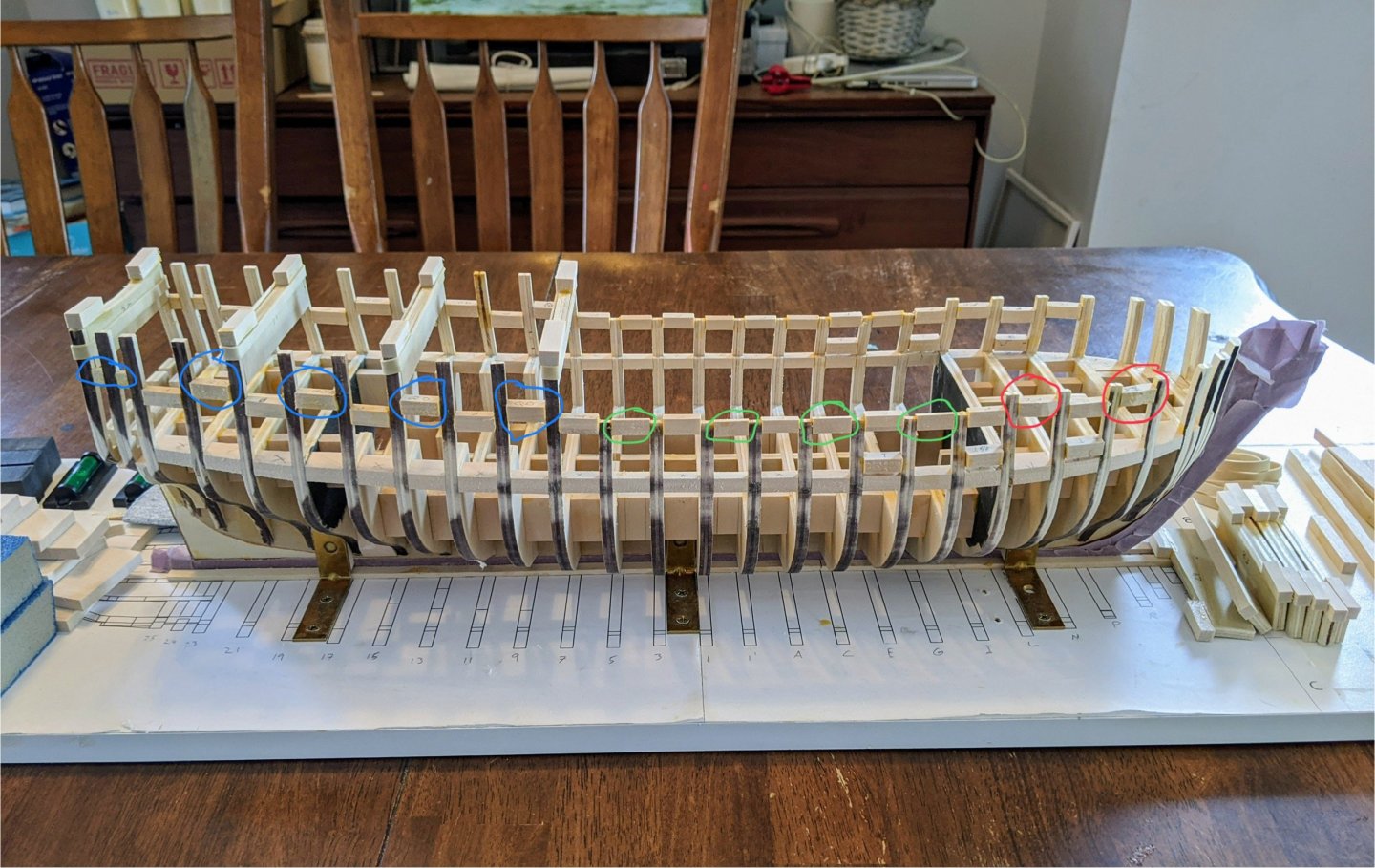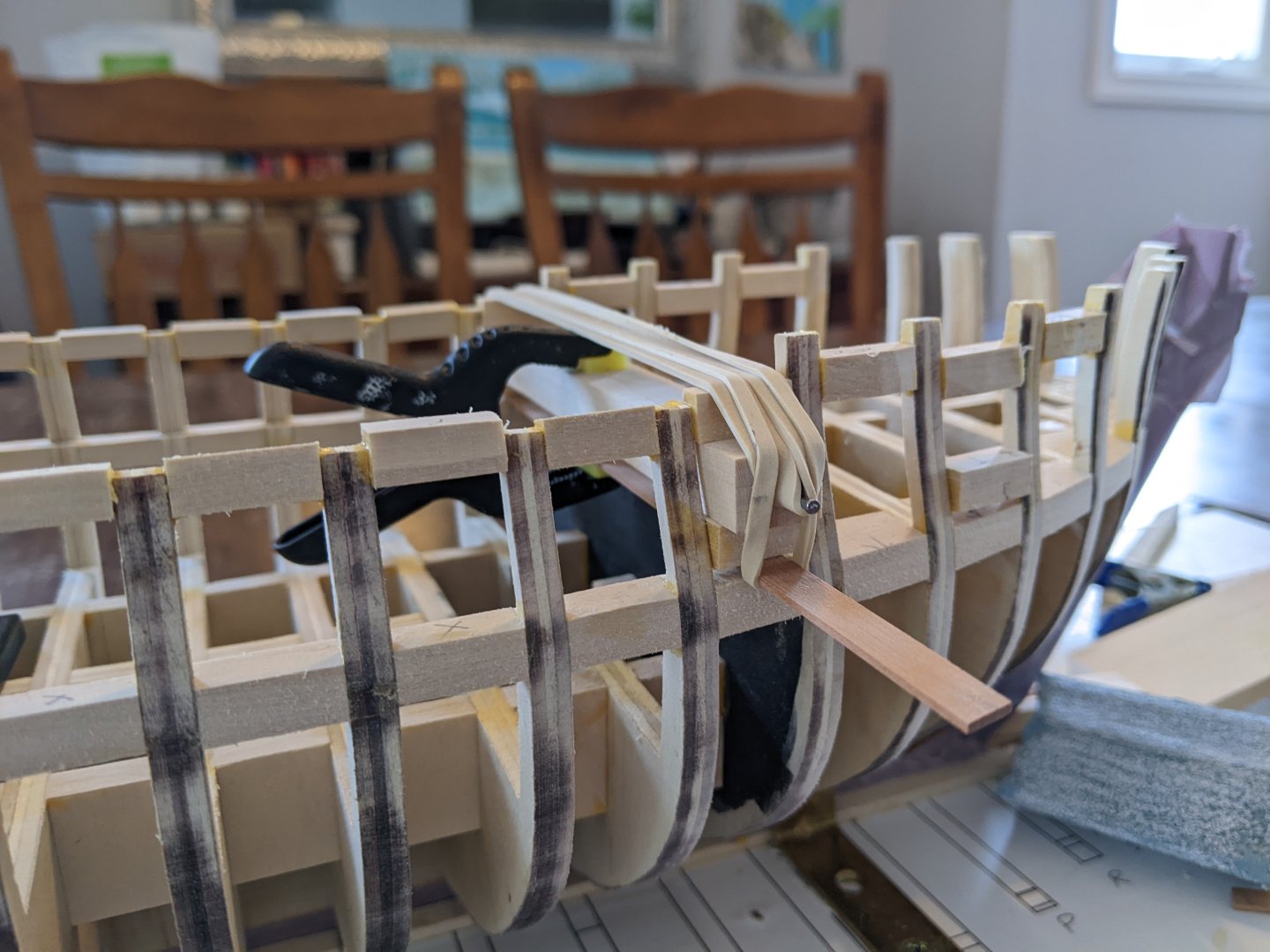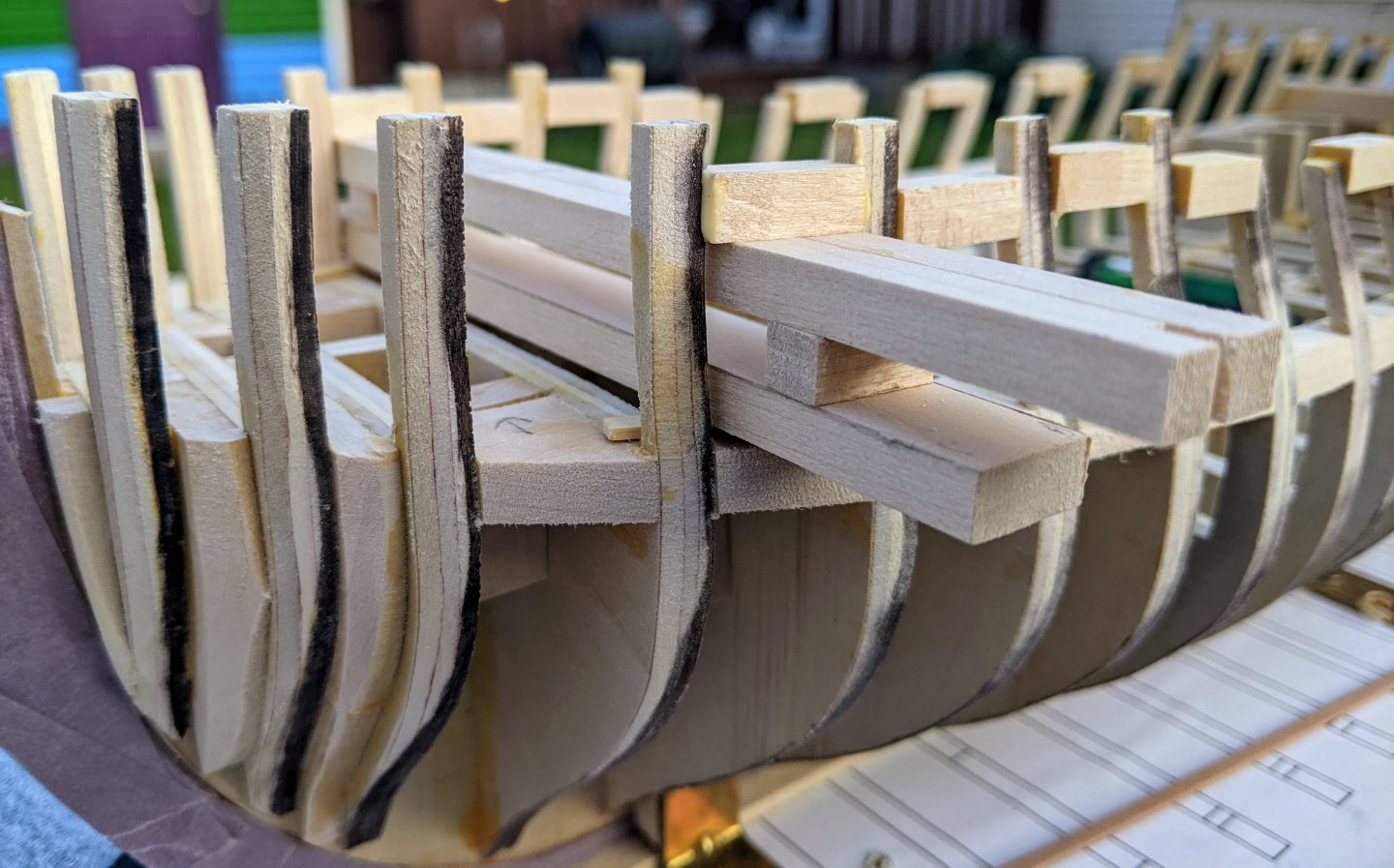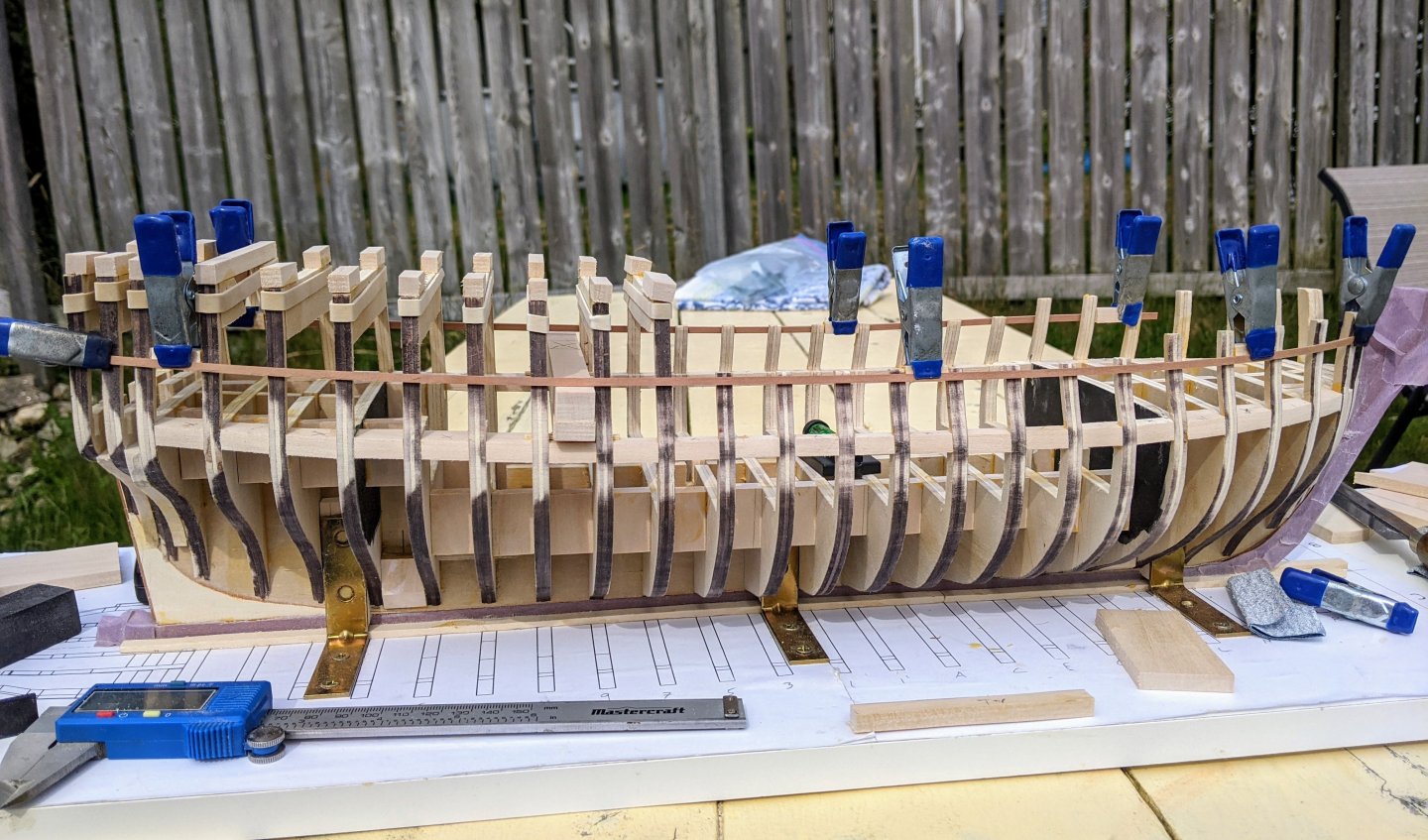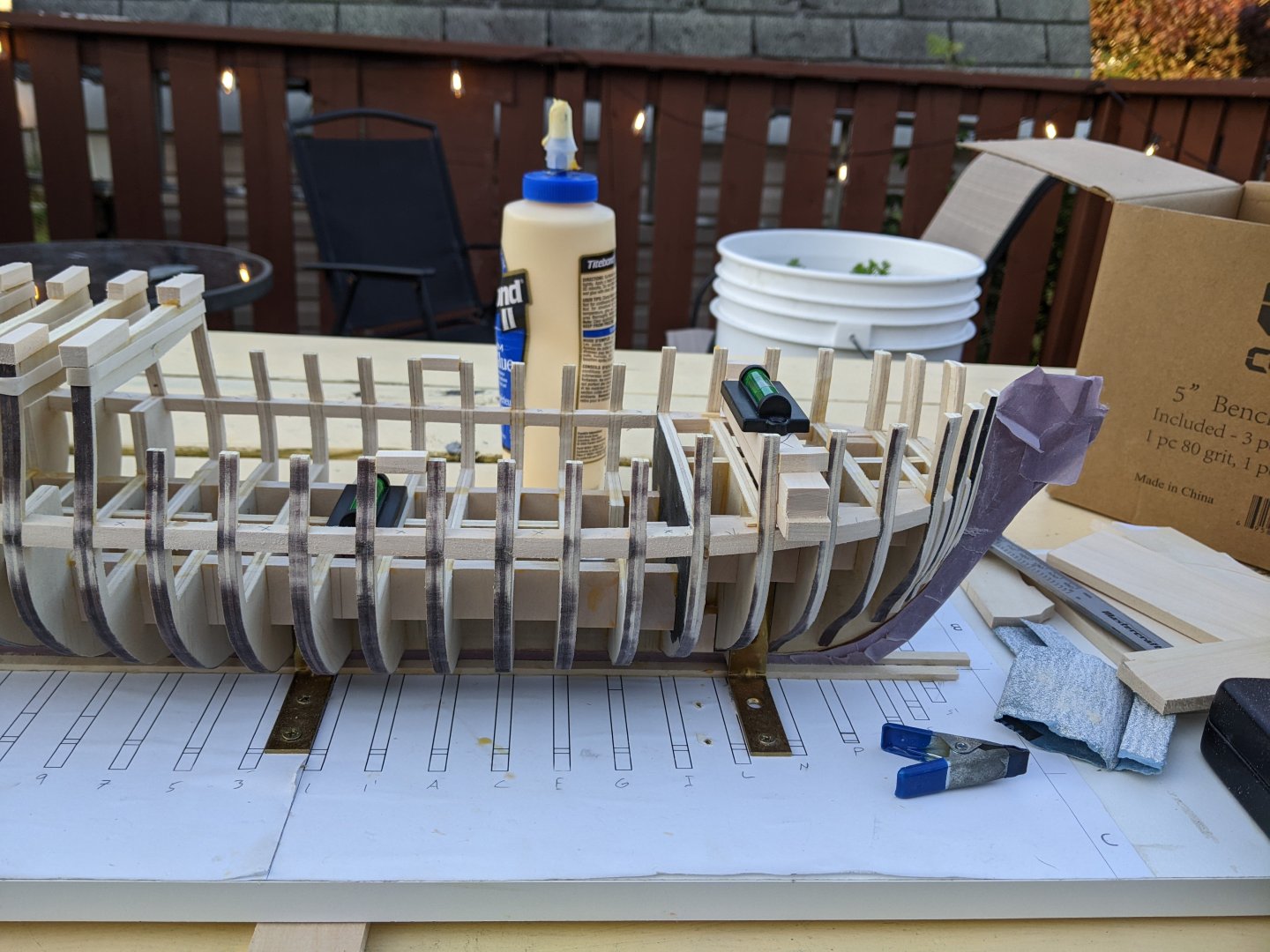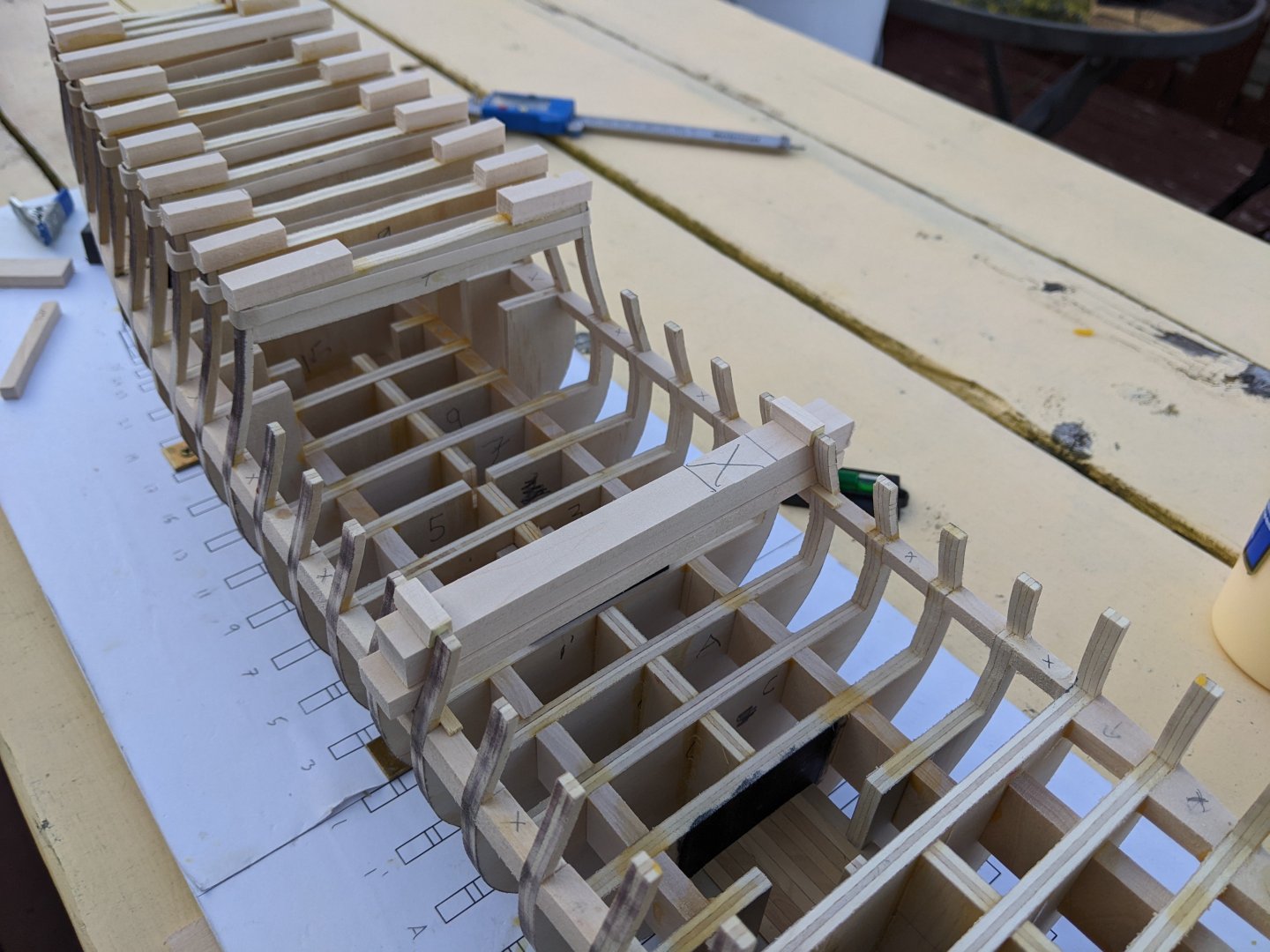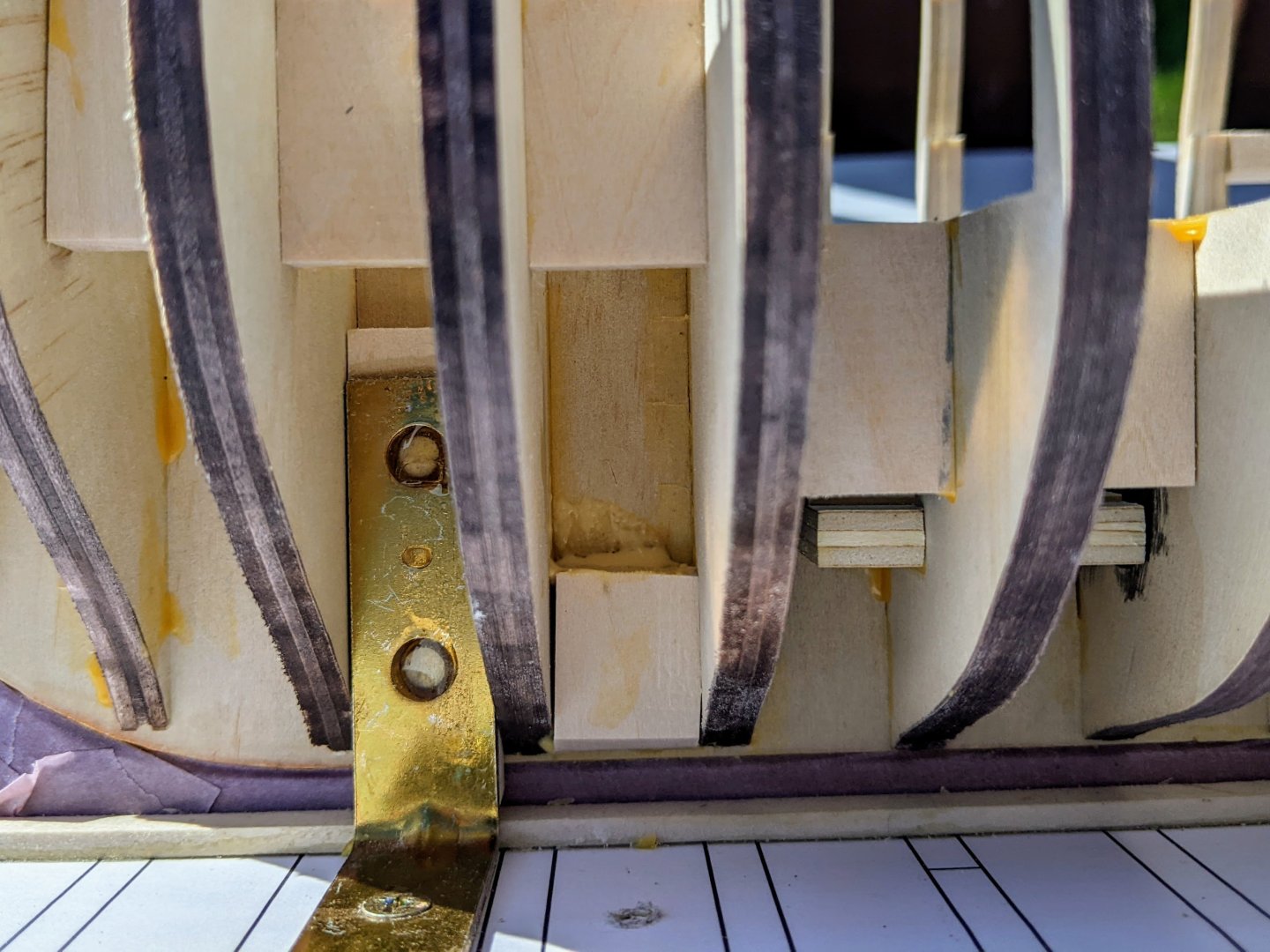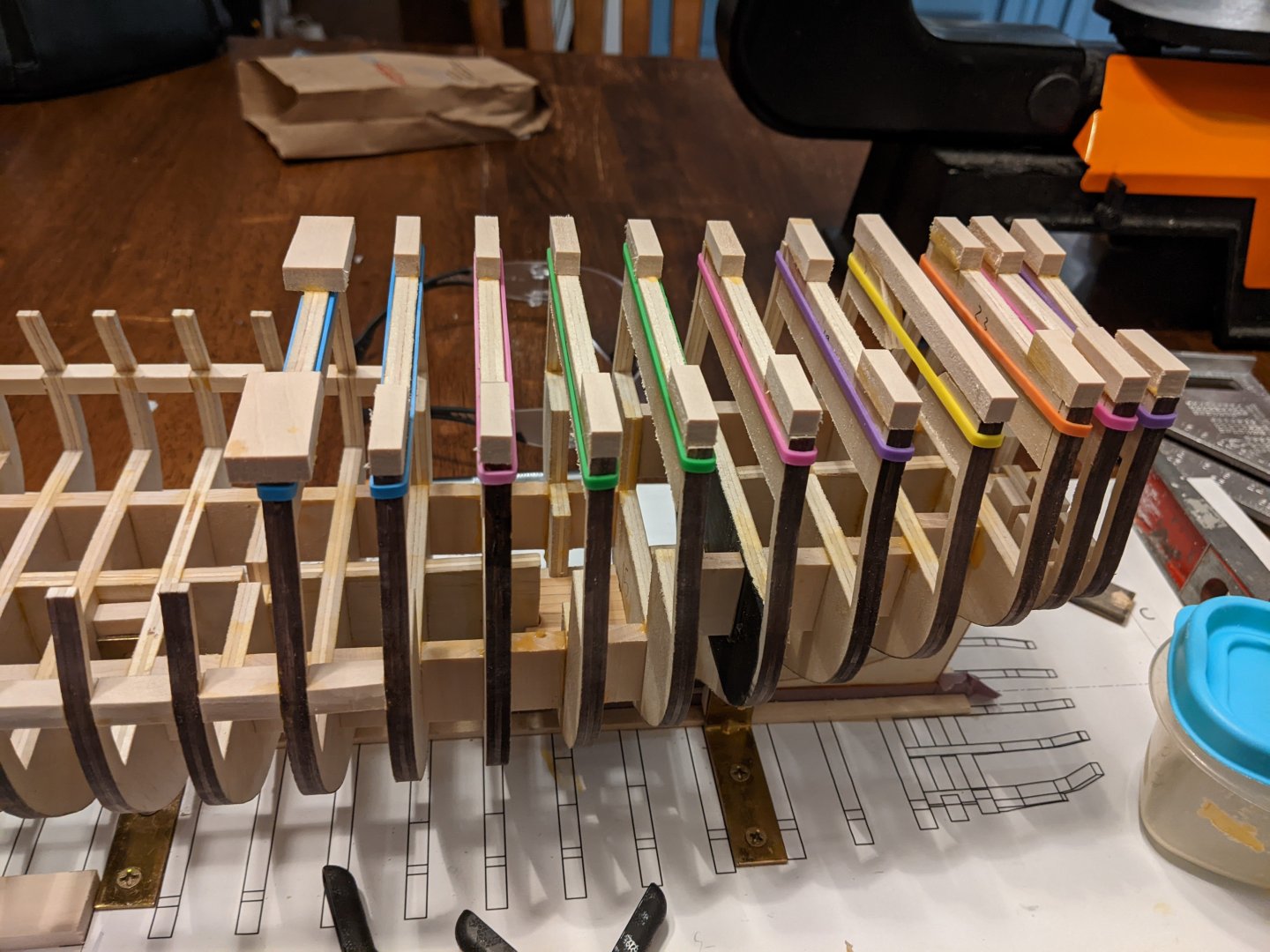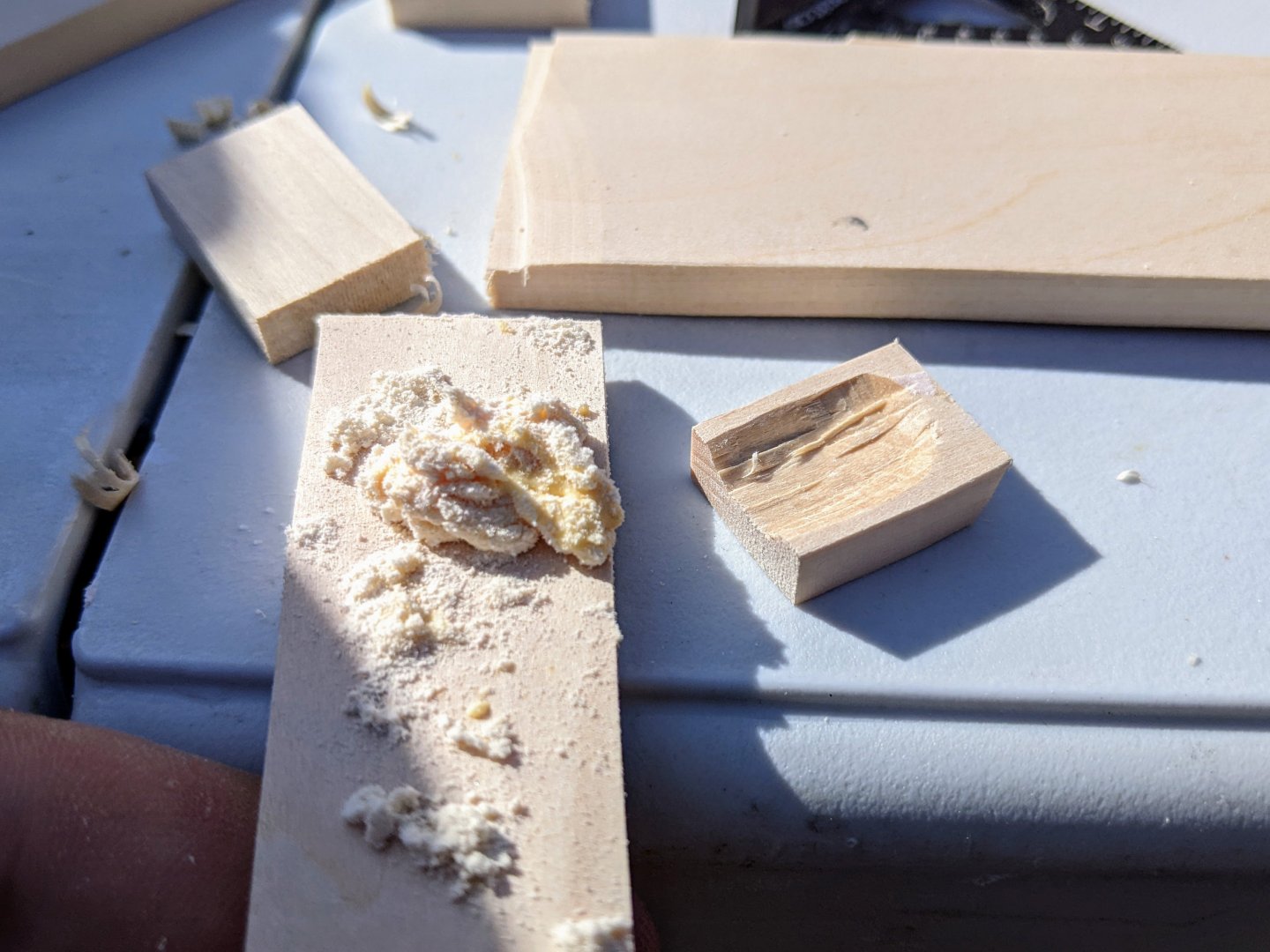-
Posts
1,345 -
Joined
-
Last visited
Content Type
Profiles
Forums
Gallery
Events
Everything posted by Thukydides
-
I also struggled with how to splice smaller lines and what I ended up doing was adding dowels to the end of two alligator clips. The dowels can then be slid through the holes and the second set of clips can then be used on the dowels to hold them the correct distance apart. I made a short one and a long one so I could use one or both of them depending on how much line I needed to serve. This allowed me to serve very small pieces that I needed to have the holding points much closer together. I was looking through my alert album and I don't seem to have a picture of it. I can take a picture later if you really want to see the actual setup, but the below drawing should illustrate it pretty well. The blue is the dowels, the red, the alligator clips and the green the line being served.
- 341 replies
-
- Sophie
- Vanguard Models
-
(and 1 more)
Tagged with:
-
Log #28: Framing the Gun Ports Part II Thanks to everyone for all your encouragement and feedback. In particular thanks to @druxey and @Pirate adam for your insight on the wales question. Barring any significant evidence showing up I am planning on going with the double strake of top and butt and the single of butt for the wales as per what can be seen on the Sphinx planking expansion. Over the past few weeks I have continued my work on the gun ports. One happy coincidence of my plans is the fore side of all of the gun ports (except for the first on each side) lined up with a bulkhead, so my task with the ports was made much easier than it could have been. I made some jigs to allow me to place the other side of the port in the correct position aligning with the frame. The sides of the port are always perpendicular to the keel, but the angle of the top and bottom of the ports changes depending on the sheer of the deck at that location. The jig was essentially two pieces of wood which I precisely cut to the width of the ports (28 in according to the contract or 7/16 in at our scale). These were then aligned on a spacer bock and then a small piece of wood to hold the jig off the floor of the port to allow it to rotate to the correct angle for the bulkhead. You can see the jig below aligning one of the gun ports. As a general rule I used more material than was necessary as I would sand it all off later. You can see below what things looked like once all the ports (except for the most forward ones) were sided. This also represents the first time I have taken the ship off of the build board since I started construction. The hull is now rigid enough with all the bracing pieces I have added that it shouldn't twist anymore. I still keep it on the build board for storage, but faring is much easier if I can hold it on my lap. This brings us to the faring. I don't think much needs to be said about this as this topic has been covered by many logs in the past, but I will note a few things that I encountered which may be useful to keep in mind for other first time scratch builders. Slower is better - Faring is such a lengthy laborious process I am tempted to rush, but it is very easy with a few misplaced swipes to take off too much material. Thankfully I caught all of my mistakes along this line before they went too far, but something to keep an eye on. Having the marker on the outside of the frames so I could judge easily how much of them I had sanded was invaluable for this. Keep an eye on finished areas - The masking tape I have on to cover the keel and knee of the head needed to be replaced a few times (particularly around the bow) as it was easy for sanding to rub the area. Use the right tool for the job - Something I found helpful in avoiding oversanding was to make sure I was using the correct shape of sanding stick / block for the area I was working on. At midships you can use a large block and sand in all directions as the curve is convex, but in concave areas you need to carefully choose the size of your sanding stick and sand in very particular directions to get the correct run of the lines. And here is Perseus with one side preliminarily fared. Once I do the framing of the stern then I will do a final pass, but I don't expect to have to remove much more material. You may also notice that I filled in the gaps between the port sides and the next frame to strengthen the areas after one of them got a bit loose. That is all for now. Thanks for stopping by.
-
Yes that is the current plan. I feel like the combination of the Sphinx drawing (which probably dates to the late 1790s) and the fact that all of the three strake wale drawings from the time period (including Harpy which was taken at the time Perseus was building) show top and butt is reasonably conclusive. I remain open to any other info the comes my way (part of the reason for doing the post now as opposed to waiting till it was actually time to do the wales), but I suspect that top and butt is the way to go for Perseus and any other Sphinx class ships.
-
Log #27: Researching the Wales of Perseus It has been a little while since I did a log post on the research going on in the background and so I figured I would take some time to share some of what I have found. So below is what I have been gathering on the wales of Perseus. Please let me know if you know of any other contemporary sources I may have missed and as always I am interested to hear if you think I may be misinterpreting something or you have other evidence which might impact my conclusions. The Wales Naval shipwrights in the late 18th century appear to have employed at least four different methods of planking the wales of single deck ships of war. As the wales were the primary longitudinal stiffener for the hull of the ship, they were typically constructed with much thicker planks than the rest of the outer planking and tended to have the strakes locked into each other. There were three main ways of achieving this: top and butt, anchor stock and hook and butt. According to the contract, Perseus’ main wales were composed of three strakes. However, the contract does not specify the method by which the planks were to be laid apart from overall width and specifying the shift of the butts. The below table summarizes planking expansion plans held by the National Maritime Museum for single deck ships launched from 1770 to 1805. Of these plans, six depict a top and butt arrangement for the wales and one anchor stock. Planking Expansions For Ship Rigged Vessels 1770-1805 Name (Guns) Launch Date Plan Date Wales Planking Style Number of Strakes Sphinx (20) 1775 1808 Top & Butt 3 Hornet (14) 1776 1776 Top & Butt 3 Thisbe (28) 1783 1807 Anchor Stock 4 Squirrel (24) 1785 1808 Top & Butt 4 Hawk (16) 1793 1803 Top & Butt 3 Cormorant (16) 1794 1793 Top & Butt 4 Diana (38) 1794 1808 Top & Butt 4 Source: NMM ZAZ3918; ZAZ5119; ZAZ3442; ZAZ3704; ZAZ4731; ZAZ4347; ZAZ2343. The most obviously applicable of these plans is the planking expansion for Sphinx, the lead ship of the class Perseus belonged to. The wales on this plan show three strakes, consistent with the contract for Perseus, in a top and butt arrangement. The dating of the plan is after Perseus was broken up, but as has been discussed, the plan is likely consistent with Sphinx’s appearance much early in her life. However, perhaps the most interesting plan is of Hornet, a 14 gun sloop launched around the same time as Perseus. The plan is of particular interest as the lines were taken on 3 February 1776 while the vessel was under construction. Perseus was launched in March meaning that the lines were taken while Perseus was being constructed just down the river. Planking Plan, Hornet National Maritime Museum, Greenwich, London, ZAZ5119. It depicts the wales in three strakes with the upper strake planked in a butt pattern and the lower two using top and butt. Though the ship is a fair bit smaller than Perseus, the number of strakes used in the wales are the same. A frequently cited secondary source for the appearance of the Sphinx class ships is McKay’s book on HMS Pandora, a slightly larger contemporary vessel of 24 guns. The book depicts the wales in four strakes arranged in a hook and butt pattern. The source for this assertion is the contract for Squirrel 1785 which says: However, though a planking expansion for Squirrel dating to 1808 does indeed show 4 strakes, they are arranged in a top and butt fashion similar to the Sphinx plan. It is possible that the wales were modified at some point in her career, but alternatively it is possible that the language used in the contract does not actually imply hook and butt. Rather, the strakes were to lock into each other in some fashion and the exact method was left to the discretion of the shipwright. It should also be noted that Pandora was slightly larger than Sphinx and Squirrel larger again, over 11 feet longer than Sphinx. This is also reflected in the wider wales (four strakes for Squirrel vs three for Perseus). The National Maritime Museum holds two models contemporary to Perseus which depicted the wales in detail. The first of these dates to about 15 years prior to the launch of Perseus, while the second dates about 15 years afterwards. The first of these, a model of HMS Bellona, depicts a hook and butt pattern for the lower wales. The upper wales use simple butt joints. Model of HMS Bellona, Circa 1760 National Maritime Museum, Greenwich, London, SLR0503. A second model of an unnamed 3rd rate uses top and butt planking for the lower wales while the pattern for the upper wales cannot be discerned from the images available online. Model of 74 Gun Third Rate, Circa 1790 National Maritime Museum, Greenwich, London, SLR0558. While there is no definitive conclusion that can be made regarding the planking methods used for Perseus’ wales, it seems most probable that top and butt planking was used. The only example from the period using hook and butt appears to be Bellona, a much earlier and larger vessel. Almost all of the examples contemporary to Perseus show top and butt style planking of the wales.
-
Fantastic job. I have enjoyed following along and watching your research processes. You should be proud of your work.
- 312 replies
-
- Chile
- Latin America
-
(and 6 more)
Tagged with:
-
Log #26: Framing the Gun Ports Part I I have started work on one of the more consequential parts of the structure of Perseus, the gun ports. These represent one of the one of the visual focuses of the model. The line of the gun ports catches your eye so getting the sweep of them right is important to making the model look right. As I mentioned in my last post I have been working on getting the inboard sweep of the deck right and that was my starting point for measuring the ports. Given the size of the basswood I was using for the framing (1/4 inch), there would not be much space below the lower port so I decided to start with the top of the ports. Starting in the middle of the ship, I used a jig to measure a consistent height. The jig is built from 3 layers. First on each side I had a small strip of wood which was used to line things up with the sheer of the deck at that point. On top of these were some folded paper (as this was the easiest way to add consistent small amounts of thickness to get the height right) followed by a spacer piece 1/4 in thick. Above this was a piece of wood the exact height of the ports. This also allowed me to check using a level that the ports were the same height on both the starboard and larboard sides of the ship. I then glued the upper port frames to the bulkheads using the jig to position them at the right angle and height. I did one of the middle ports and the ones at each end before using a batton to check how things looked. Every time I did another port I would check how it fitted with the batton and adjust the inboard profile of the deck as necessary. At this time I also placed cross bracing pieces between the bulkheads at the height of the forcastle and quarterdeck beams. For the forecastle I used spacer jigs (similar to the ports), but for the quarterdeck I had to be a bit more creative as according to the contract, the fore end is a different height than the aft end. So I measure and marked the two ends and then used battons to make a smooth sweep. This is not as important to get perfect as these heihts can easily be adjusted later and the main point of these bracing pieces is to strengthen the structure in the space between bulkheads that don’t have ports. You can see below a picture of the jig used for the quarterdeck. For the lower pots I used my jig for the port heights held up by a rubber band. I then used an old piece of scrap wood to apply pressure to the bottom of the port framing to hold it against the bottom of the jig at the correct height and angle. And this brings us to where things currently stand. I am still working on the lower framing for the ports, but the strengthening structure has allowed me to remove some of the bracing pieces I had in place. The top of the quarterdeck beams follow the line of the top of the pieces circled in blue, the forecastle the ones circled in red and the green ones are just extra pieces I added to strengthen the structure. You can see that I have 3 of the ports framed (though I still need to add vertical pieces to set the width). I also still need to prepare the framing of the foremost port, but that will first require some more faring as it is on the curve of the bow. Thanks to everyone for all your encouragement.
-
I only did this after it was on the model. This was mostly to remove the shine of the poly rope and any super glue that was visible, but also helped protect and hold everything in place. If you do it earlier then you can make white bits of varnish flake off as you are manipulating it (not a good look). If you are looking at my log then look at my later rigging work as opposed to the earlier stuff. I got a lot better as I went along and found better ways to do things.
-
Good to see you back at it. Serving is a bit tricky. It takes time to figure out the twist and the tension. I found mechanically fastening the ends as well as glue helped. I would use a needle to run the serving thread through the rope being served with a very small bit of super glue on that part to hold it there. Also I found that magnification helps a lot. If you are looking for ideas you can check out my alert log. I discuss much of this in detail there.
-
Looking good. The stern area is a bit of a funny one with a lot of inconsistencies between the Marshall painting, the plans and the Goodwin book. I ended up redoing mine after the fact. If you are feeling really adventurous you could try painting the counter and transom as per the Marshall painting of Alert.
-
Log #25: More Structural Supports and the Deck Sheer It has been almost a month since I last posted as I have been busy with other tasks and though work has progressed, there had not been a lot of significant progress. One challenge is this work generates a lot of dust and so I have been trying to do it outside (I don’t have a dedicated workshop space). Between rain and the fact that most of my free hobby time is in the evening, this has slowed the process down a bit. Along the way I realized that the existing inserts I had taped in place to support the thinner bulkhead extensions were in the way and so I cut off the bottom of them and added glued pieces above them to hold them in place. Then I place rubber bands around the whole upper part of each bulkhead to hold it together. This is actually more sturdy than what I previously had done and it also keeps the supports out of the way. I have been doing some preliminary faring as I add the bracing pieces along the sheer of the deck. The bracing pieces are now all in place, though the ones near the bow and stern have not been fared at all yet. As you can see from the below picture, the sheer is not perfect and so now I need to make small adjustments inboard to make sure the line of the deck is right. Then I can use that line to measure the gun port heights. The sheer will also allow me to measure and mark the height of the quarterdeck and forecastle and I will likely add bracing pieces to mark their locations before I start faring in earnest. I have also taken the opportunity to reinforce the area where the nuts are glued to accept the bolts that will attach the model to the base. To do this I cut pieces of basswood and then used my mini chisels to hollow them out. I then filled this hollow with a wood glue sawdust mixture. This was then pressed in place over the area of the nuts until the excess sawdust-glue mixture started to squeeze out indicating the area was fully filled. This is probably overkill, but as it didn’t take much time, I figured it was worth the effort to make sure that these don’t come loose. So that is all I have to show so far. Thanks to everyone who had stopped by to take a look. On the research side of things I don’t have much to report as I have only had time to transcribed a couple letters and they didn’t have any particularly significant info in them. Hopefully the next ones will have some more interesting information.
-
There is also a significant amount of evidence to suggest that the false keel was not coppered (at least with regard to British ships). Also some ships also had the uppermost layer of plates done after the fact running along the waterline to sort of finish off things. It seems that the upper edge of the covering was covered by a wooden batten or possibly canvas, but there is very little said on it and specifics are hard to come by.
-
Great progress jaques. The sails are looking really nice.
- 312 replies
-
- Chile
- Latin America
-
(and 6 more)
Tagged with:
-
Looking good. I have also been experimenting with tin foil for the water though in my case I am going to be using it directly on the base. I have found at least so far it really helps in getting a dynamic base working.
-
You essentially have two options. 1) You can carefully remove the offending planks and replace them. This is the option I would go with. Note this is the only real option if you are planning on leaving the hull unpainted. If you used super glue to attach the planks then careful use of acetone can help with removal. For wood glue isopropyl works well. 2) you can leave as is, maybe add some more filler just making sure the shape is smooth and right. If you are painting it white then it shouldn't be that noticable. Good luck.
-
They do look really nice. Harpy is also looking good.
- 332 replies
-
- Harpy
- Vanguard Models
-
(and 1 more)
Tagged with:
-
Great job Glen, I think you made the right choice. Just a little bit of green adds a nice bit of colour. It is a fantastic model with a great presentation.
- 106 replies
-
- Kentoshi-Sen
- bottle
-
(and 1 more)
Tagged with:
-
Great work on the bottle. It looks fantastic.
- 312 replies
-
- Chile
- Latin America
-
(and 6 more)
Tagged with:
About us
Modelshipworld - Advancing Ship Modeling through Research
SSL Secured
Your security is important for us so this Website is SSL-Secured
NRG Mailing Address
Nautical Research Guild
237 South Lincoln Street
Westmont IL, 60559-1917
Model Ship World ® and the MSW logo are Registered Trademarks, and belong to the Nautical Research Guild (United States Patent and Trademark Office: No. 6,929,264 & No. 6,929,274, registered Dec. 20, 2022)
Helpful Links
About the NRG
If you enjoy building ship models that are historically accurate as well as beautiful, then The Nautical Research Guild (NRG) is just right for you.
The Guild is a non-profit educational organization whose mission is to “Advance Ship Modeling Through Research”. We provide support to our members in their efforts to raise the quality of their model ships.
The Nautical Research Guild has published our world-renowned quarterly magazine, The Nautical Research Journal, since 1955. The pages of the Journal are full of articles by accomplished ship modelers who show you how they create those exquisite details on their models, and by maritime historians who show you the correct details to build. The Journal is available in both print and digital editions. Go to the NRG web site (www.thenrg.org) to download a complimentary digital copy of the Journal. The NRG also publishes plan sets, books and compilations of back issues of the Journal and the former Ships in Scale and Model Ship Builder magazines.

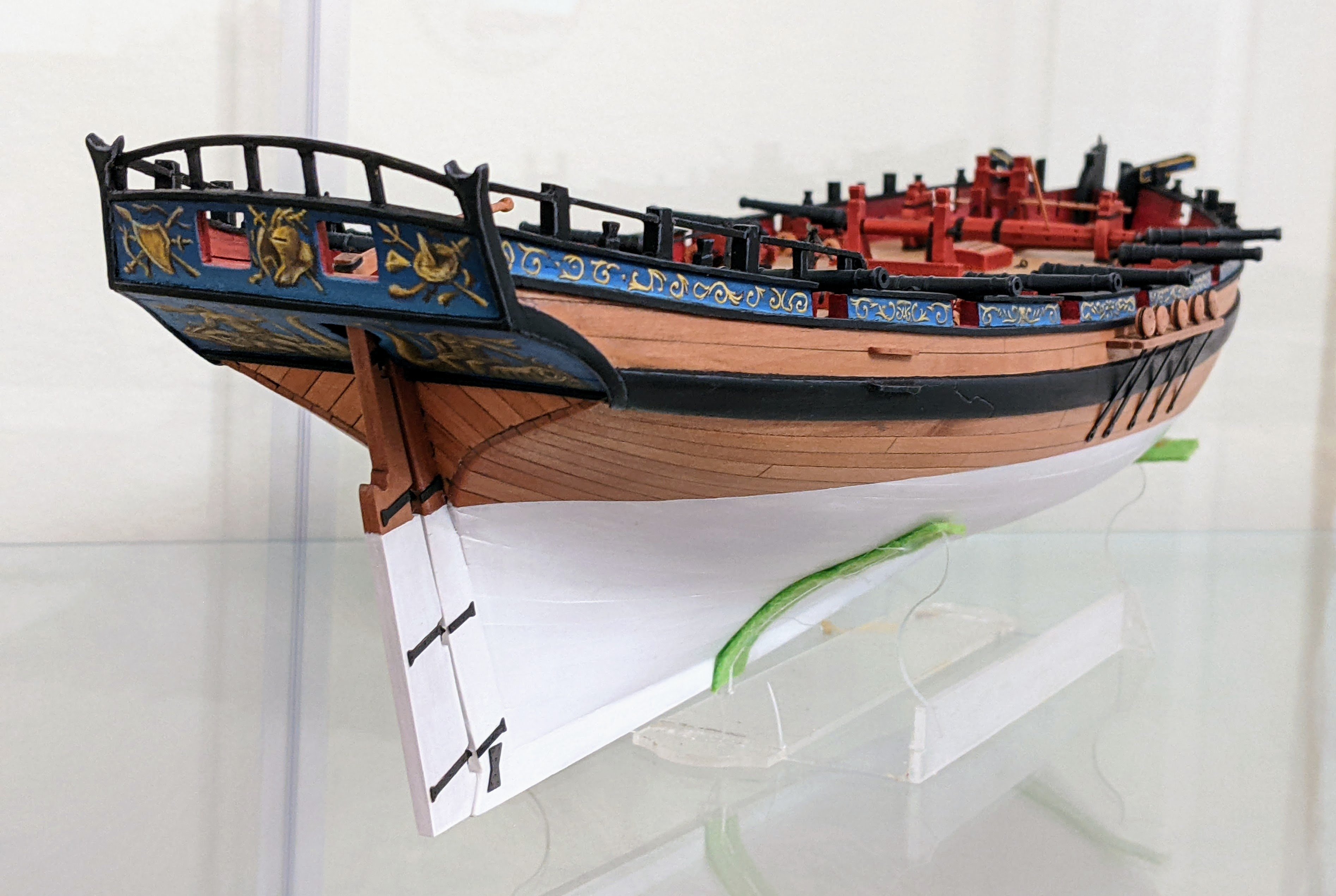

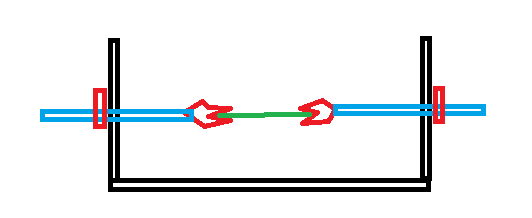


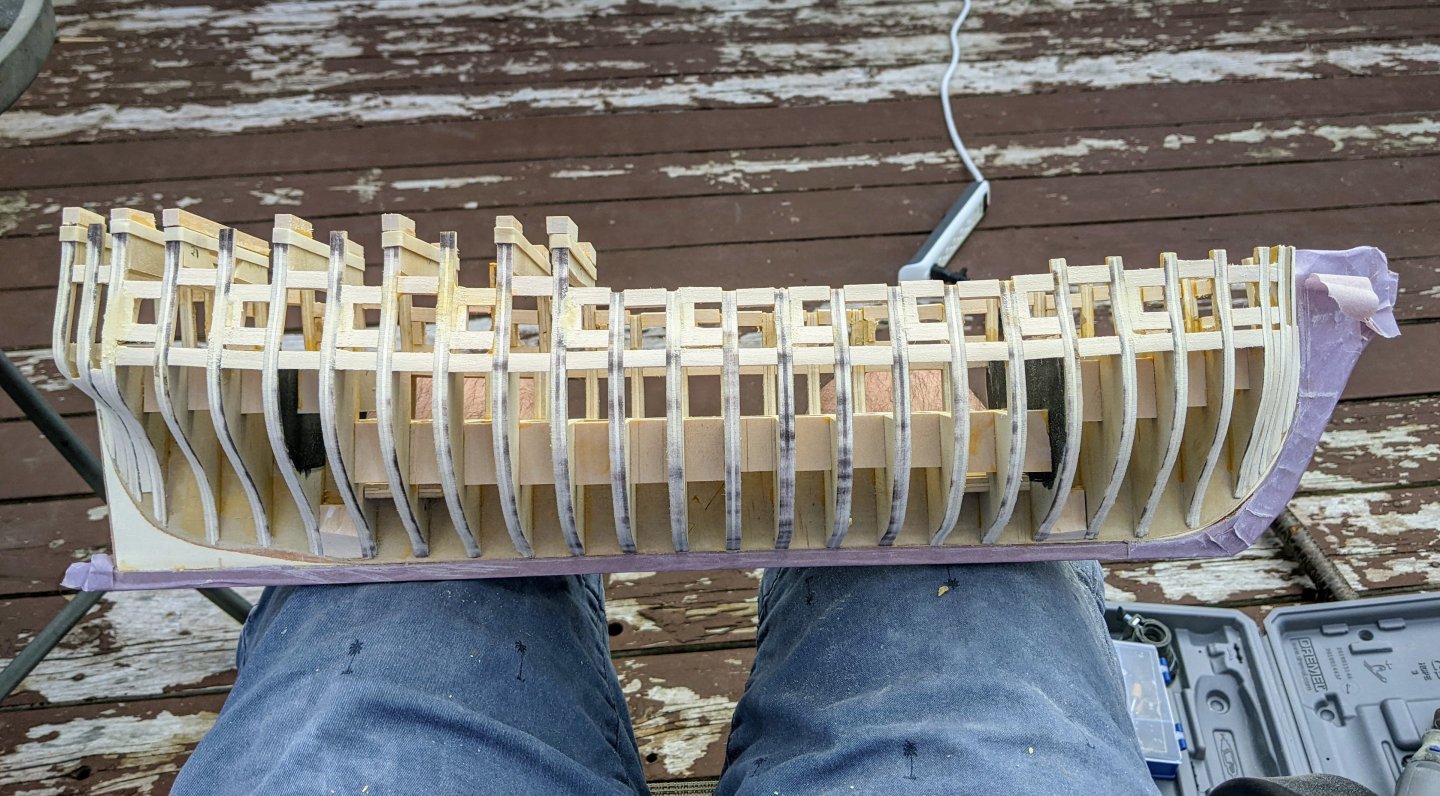
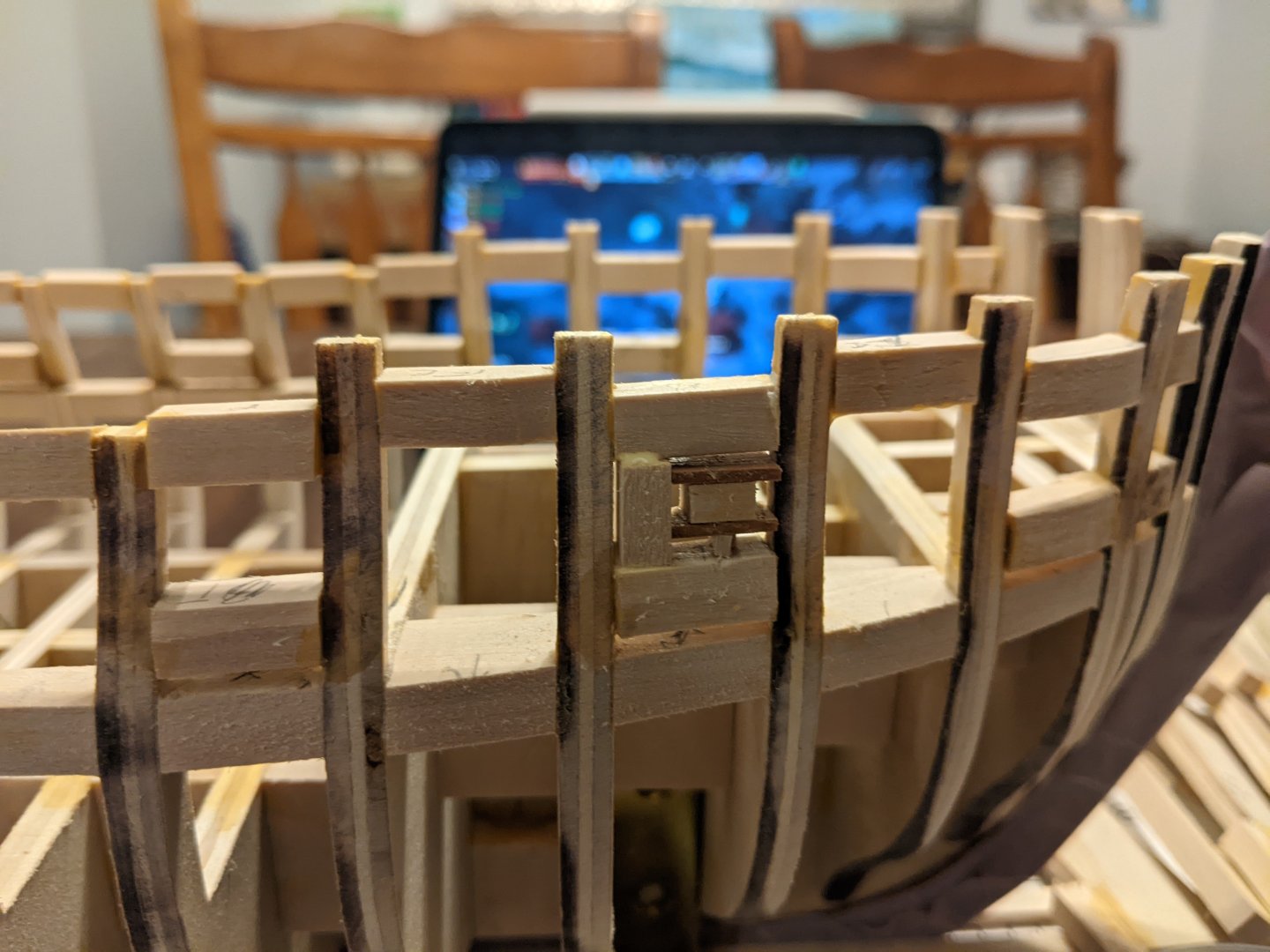
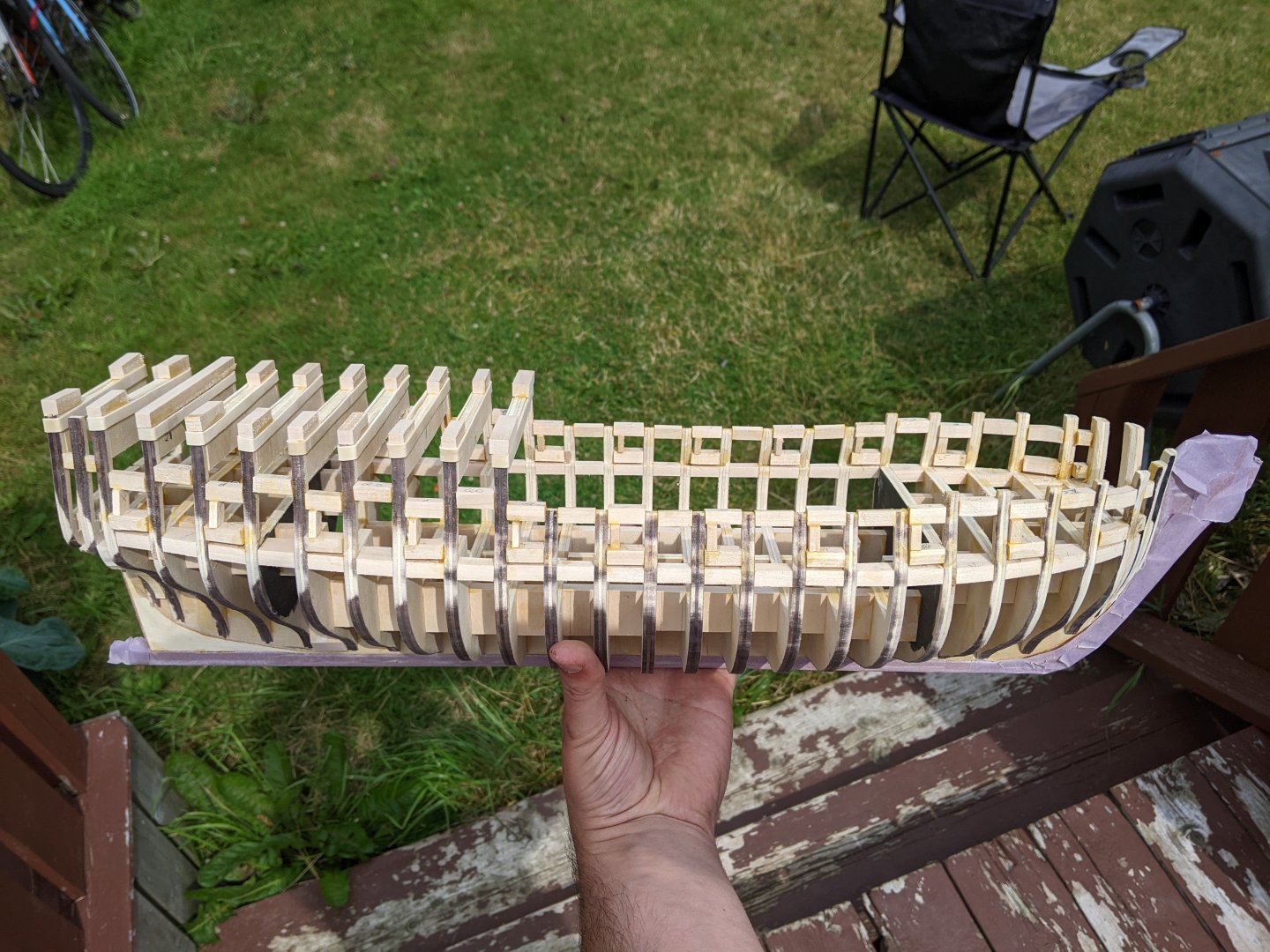

.jpg.cbcad1869bb8fb438ea861ab6f9418e2.jpg)

